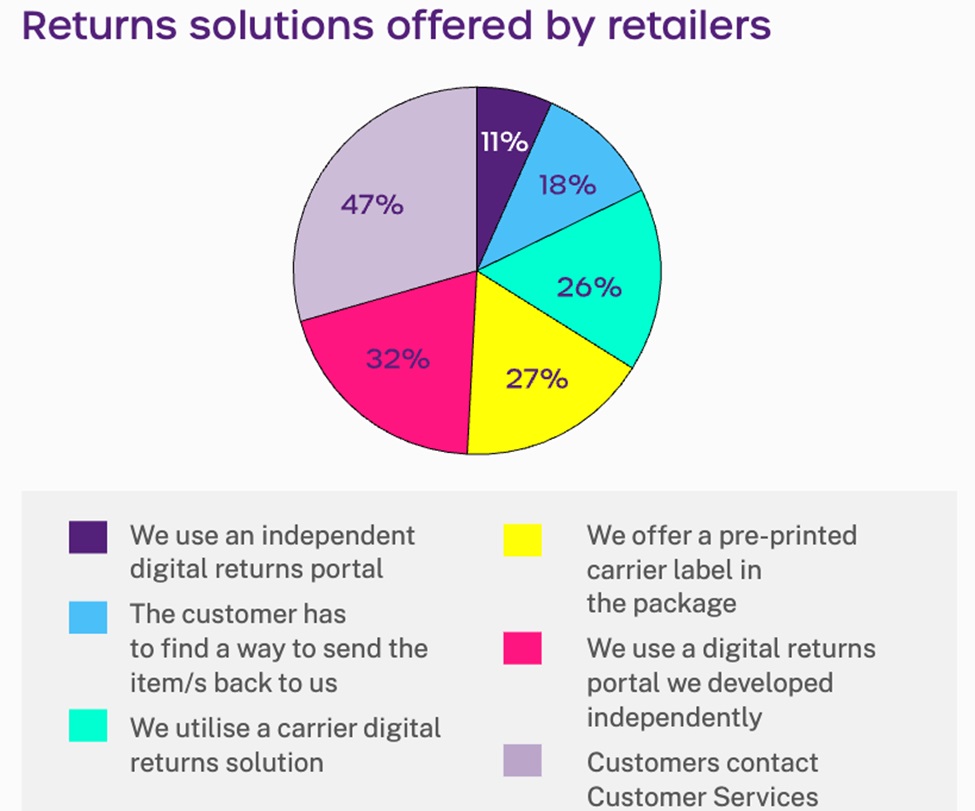
Doddle report reveals carrier opportunity amidst fragmented e-commerce returns market

The latest return report from Doddle highlights two important but seemingly contradictory data points about returns.
- 84% of merchants believe their returns processes are good or very good.
- 75% say that improving them is a high or very high priority.
One conclusion we can draw here is even if retailers might mark their solutions as ‘good’ – they haven’t figured out the entire process yet. They may not know where their issues lie, find them difficult to address, or lack examples of what good looks like in the market, but they acknowledge they have a problem and want to fix it.
In that area of uncertainty, carriers have an opportunity to step up in the market, providing solutions that solve returns issues in a fragmented and inconsistent market where retailers don’t have the knowledge, know-how or resources to address.
Returns solutions are fragmented and inconsistent
When asked what returns methods they use, European retailers responded with a broad mix of solutions and propositions. Sometimes, even within single merchants, options vary, where the same item might have to be returned differently depending on which channel it was purchased through. For example, items bought in-store could be returned in-store, while items purchased online had to be shipped back.
The most common method of returns initiation was for customers to contact customer service, with 47% of European merchants using this service in returns offerings. This method will likely involve a more manual approach to authorisation, approval and label generation. It is more expensive than a digital framework where the returns policies are effectively baked into the user journey, rather than discussed with a customer support agent.
Pre-printed carrier labels were also offered by 27% of retailers, which consumers can use to return an item at any time. This method doesn’t allow retailers to enforce their returns policy at the point where consumers ship the item, meaning retailers are likely to experience ineligible returns being sent, wasting time and money in shipping, handling and grading, as well as determining refund authorisation for each return. In addition, printing hard-to-recycle sticky labels in each package when, on average, 70-80% will not be used, generates significant waste and unnecessary cost.
18% of retailers also reported having the customers find a way to return items to them of their own accord. Presumably, these merchants aim to limit returns, though putting so much onus on the consumer might put off shoppers from purchasing in the first place, even if it does reduce the volume of returns received.
These return initiation processes struggle to combine a great customer experience with control and visibility into returns for the retailer. Making shoppers contact customer support retains control over returns, but at the expense of an inconvenient customer experience. Putting labels in boxes makes the customer journey really easy, but at the expense of control and insight for the retailer. Only digital returns portals (offered by only 39% of retailers) have the power to track accurate returns data, including the reason code for returns, without requiring manual customer support resource.
As revealed in the returns report, 75% of retailers say that return reason is a requirement for returns. The fact that a quarter of retailers are not even attempting to track the reasons for returns (and still more only get patchy or unreliable data about return reasons as a result of paper-based processes) demonstrates just how much could be improved by wider adoption of digital solutions.
However, as we dive deeper into the digital solutions retailers are using, more inconsistencies appear.
Not all digital solutions are the same
39% of retailers surveyed used either an independently or internally developed returns portal. 32% of retailers surveyed said that they’d developed their own returns portal, and 11% use a third-party provided portal (there is some overlap between these groups with some merchants using both solutions).
Not all digital portals are equal. They can be divided into two main categories: integrated and isolated.
Integrated portals are digital portals that are connected to retailer data. When customers enter their order number, this is checked against the system to match the exact transaction and items. On the other hand, isolated digital returns portals aren’t connected to merchant data. There’s no validation or checks; the system records the interaction and provides shipping labels.
From a customer perspective, integrated portals provide a smoother customer journey where shoppers are presented with their recent purchases and can select which ones to return and why. For retailers, integrated returns portals allow visibility and control over the process – they can prevent out-of-window or ineligible items from being selected, for example. They also only pay for returns shipping on items returned, rather than printing labels for each outbound order.
While our research data doesn’t explicitly clarify whether internally developed portals are integrated to order data, we can say that at least a clear majority of merchants (61%) are still using inferior, non-integrated solutions. Presumably, one of the biggest factors for retailers using isolated rather than integrated returns solutions is a lack of resources to develop the systems internally. This is where carriers can step in to help.

Carriers aren’t meeting returns demand
The returns report found a marginal increase of usage of carrier solutions from 24% in 2022 to 26% in 2023. Considering the vast number of retailers needing help with returns, this slight increase pales compared to the potential open to carriers – so why haven’t carriers made any significant inroads in the last year?
77% of merchants who do not currently use a digital solution provided by carriers have expressed interest in using one. This is an increase of 8% since last year, indicating that the demand for carrier-provided solutions is growing. However, despite this interest, the usage of these solutions has not increased significantly, suggesting that the current demand is not being fully met.
There are two theories for why carriers aren’t currently stepping up to returns demand. The first is that retailers aren’t aware of the solutions carriers are offering. Data from the report states that 73% of merchants know that their logistics/delivery provider offers a digital solution to help with returns, regardless of whether they use them or not. However, over a fifth (21%) of our sample reported that their carrier/logistics provider didn’t offer any digital returns solution at all, and another 7% didn’t know.
In simple terms, more than a quarter of the market is not aware of carrier solutions, whether because they’re not provided at all, or not being correctly marketed to merchants.
The second theory as to why carriers aren’t stepping up is that carrier solutions aren’t meeting retailer requirements by not offering integrated portals. That limits the effectiveness of carrier returns offerings, as merchants don’t receive as much insight and control over the process.
How can carriers take advantage of the returns market?
Carriers have a significant opportunity to capitalise on the fragmented ecommerce returns market by offering integrated digital returns portals that give retailers more control over the process. This includes providing more data and analysis through returns reasons, as well as stricter rules around which returns are accepted. By doing so, carriers can help merchants improve their returns processes, reduce costs, and increase customer satisfaction.
To take advantage of this opportunity, carriers must ensure that their solutions are meeting the needs of retailers. This includes offering integrated portals connected to merchant data, allowing for more control and visibility over the returns process. Additionally, carriers must ensure that their solutions are marketed effectively to retailers, so that they are aware of the options available to them.
As Doddle data shows, over two-thirds (77%) of merchants who don’t already use one say they’d be interested in using a digital returns solution provided by their logistics or delivery provider to manage ecommerce returns. The demand is already there. It’s time for carriers to step up.










